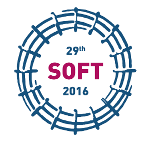Speaker
Heung-Su Kim
(National Fusion Research Institute)
Description
Noise width (δV/V) and drift level (ΔV/Δt) in the magnetic measurements by using sensors such as magnetic field probes (MPs) and flux loops (FLs) has been fully satisfied with the requirements (δV/V < 2% and (ΔV/V)/ Δt < 2% for 60 s), for the plasma control in the KSTAR tokamak before the in-vessel control coil (IVCC) is used to control plasma shapes. From the experimental campaign of 2010, the in-vessel control coils (IVCC) is required for elongated plasmas (kappa > 1.7) to achieve the H-mode discharges in the KSTAR. However, there is large noise pick-up of few kHz in the magnetic measurements during the operation of the IVCC. Thus experimental investigations of the noise characteristics are carried out for the reduction of the noise. It is found that the noise comes from the IVCC power supply in the investigation of the noise characteristics. The noise width can be reduced up to less than 1 % of the signal amplitude by adding electronic filters between the electronic integrator and the data acquisition system in the signal path for the magnetic measurement. The plasma control during H-mode discharges has been improved by reducing the noise. In this work, the characteristic of noise due to the IVCC and the low pass filter system for reducing the noise will be described. Up to now, the improvements that have been achieved in the magnetic measurements by using the filter system for achieving better plasma control in the experimental campaign of 2016 in the KSTAR will be also presented.
*This work was supported by the Korea Ministry of Science, ICT and Future Planning under the KSTAR project contract.
Co-authors
Heung-Su Kim
(National Fusion Research Institute, Daejeon, South Korea)
Jun-Gyo Bak
(National Fusion Research Institute, Daejeon, South Korea)
Sang-Hee Hahn
(National Fusion Research Institute, Daejeon, South Korea)

